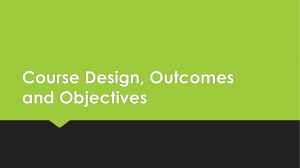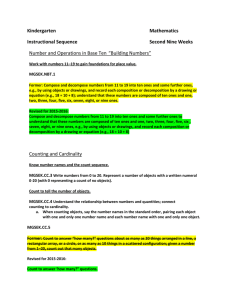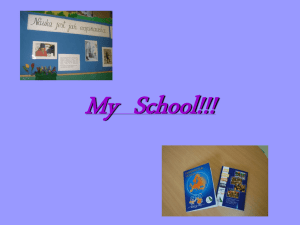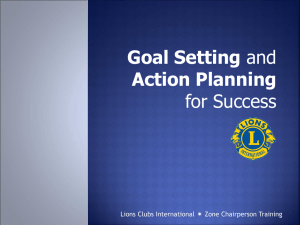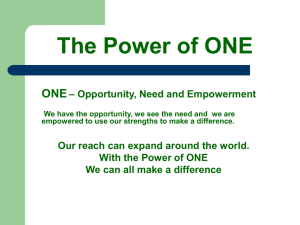Daily Learning Target Template for Teachers
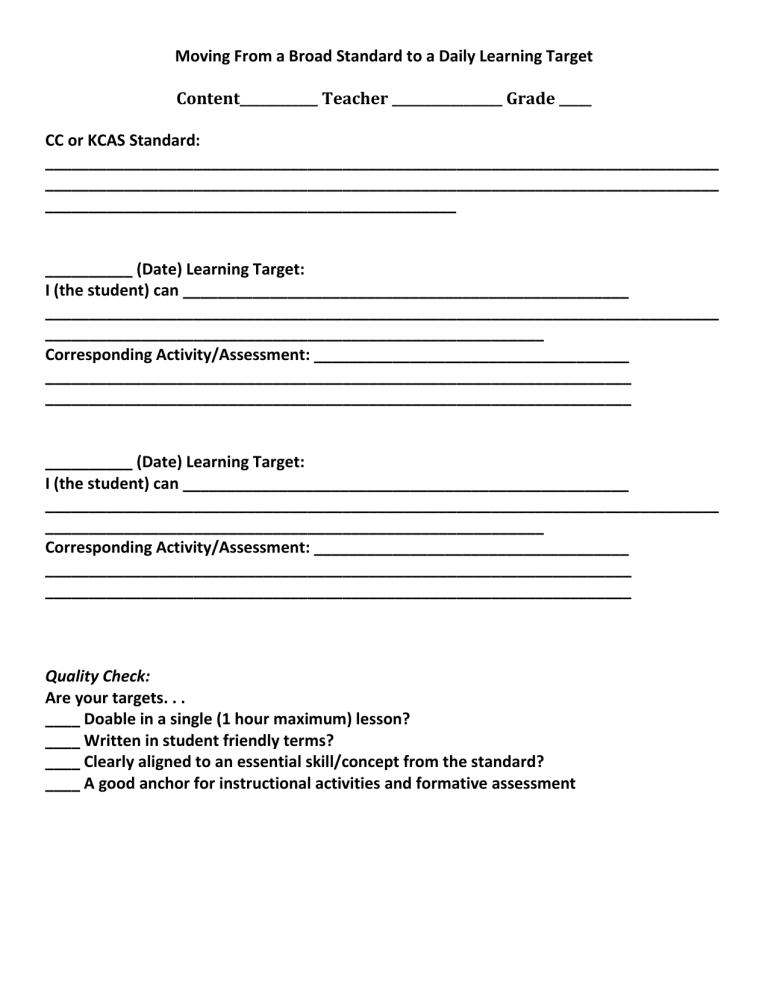
Moving From a Broad Standard to a Daily Learning Target
Content____________ Teacher _________________ Grade _____
CC or KCAS Standard:
_____________________________________________________________________________
_____________________________________________________________________________
_______________________________________________
__________ (Date) Learning Target:
I (the student) can ___________________________________________________
_____________________________________________________________________________
_________________________________________________________
Corresponding Activity/Assessment: ____________________________________
___________________________________________________________________
___________________________________________________________________
__________ (Date) Learning Target:
I (the student) can ___________________________________________________
_____________________________________________________________________________
_________________________________________________________
Corresponding Activity/Assessment: ____________________________________
___________________________________________________________________
___________________________________________________________________
Quality Check:
Are your targets. . .
____ Doable in a single (1 hour maximum) lesson?
____ Written in student friendly terms?
____ Clearly aligned to an essential skill/concept from the standard?
____ A good anchor for instructional activities and formative assessment
A Guide for Effective Learning Targets
Effective learning targets guide instruction and learning for a single classroom lesson (approximately one hour).
When designed well, learning targets
focus on appropriate content/grade level standards from the common core, college readiness or core content (for science and social studies),
use student friendly language and
include measurable objectives that anchor instructional activities/formative assessment.
The learning targets below have been annotated to demonstrate varying degrees of effectiveness and to provide additional guidance to secondary teachers as they develop and refine learning targets for their students.
Sample Target #1: Ineffective *
Course: Advanced English 10
Target (s): Be able to identify the adverbs in the sentences.
Be able to discuss the main characters in Night .
While the two targets above are certainly doable in a single class period, neither offers specific guidance to students regarding what significant concepts will be learned and practiced in class. The phrases “identify adverbs” and “discuss the main characters” lack specificity and do not link directly to any appropriate grade level standard. The phrases “be able to” and “discuss the main characters” are not measurable objectives for students.
Sample Target #2: Somewhat Effective*
Course : English 11
Targets : I can identify correct noun-pronoun-verb agreement.
I can identify major conflicts in Act 2 of The Crucible & their relationship to the plot.
These two targets offer a clearer indication of what is to be learned in class than sample target 1. Here, the teacher has narrowed the focus for students to a portion of a text (Act 2) and included more specific, standards-based concepts directly in the targets (i.e. “conflict relationship to plot” [KCAS RL3;11-12]and “noun-pronoun-verb agreement” [CRS
CU;28-32]). The “I can” phrasing of these targets is also more student-friendly and specific than sample target 1. While sample target 2 includes effective elements, it lacks measurable objectives to assist the student in assessing his/her progress toward the target. To accomplish this, the first goal above could be adjusted to read, “I can identify major conflicts in Act 2 of The Crucible and explain how each conflict impacts the plot using examples from the text.”
Sample Target #3: Effective*
Course: English 9
Target: I can revise sentences to ensure correct subject verb agreement (in compound and complex sentences).
I can explain how the ideas in Kurt Vonnegut’s editorial On Competition in American Society connect to the ideas in his short story, Harrison Bergeron .
These two targets clearly focus on concepts/skills from appropriate standards (KCAS RI3-9-10 and CRS CU 16-19).
Each target also provides a measurable objective written in student friendly language (i.e. revise sentences for correct subject verb agreement and explain how ideas connect across two works) that will drive instruction and assessment during the lesson.
* Prior to beginning the lesson, teachers must post the learning target, read it aloud and elicit feedback/ questions from students in order to effectively guide and focus instruction.
A Guide for Effective Learning Targets-Science
Effective learning targets guide instruction and learning for a single classroom lesson (approximately one hour).
When designed well, learning targets
focus on appropriate content/grade level standards from the common core, college readiness or core
content (for science and social studies), use student friendly language and include measurable objectives that anchor instructional activities/formative assessment.
The learning targets below have been annotated to demonstrate varying degrees of effectiveness and to provide additional guidance to secondary teachers as they develop and refine learning targets for their students.
Sample Target #1: Ineffective *
Course: Life Science
Target (s): Understand photosynthesis.
Be able to understand the properties of water.
The two targets above are what students will eventually be able to demonstrate. However, this is not achievable in one hour and the task is too subjective. How does one measure understanding? Be sure to have a learning target that can be evaluated at the end of the class for every student.
Sample Target #2: Somewhat Effective*
Course : Physical Science
Targets : I can identify covalent bonds.
This target can be accomplished at the end of a period by an exit slip or some other formative assessment. However, it can be altered just a bit to demonstrate higher level thinking and learning.
Sample Target #3: Effective*
Course: Earth Science
Target: I can compare and contrast the two types of waves (P and S) caused by seismic activity.
The learning target demonstrates exactly what the students will learn and how they will use the information from class to have a product.
* Prior to beginning the lesson, teachers must post the learning target, read it aloud and elicit feedback/ questions from students in order to effectively guide and focus instruction.
A Guide for Effective Learning Targets
Effective learning targets guide instruction and learning for a single classroom lesson (approximately one hour).
When designed well, learning targets
focus on appropriate content/grade level standards from the common core, college readiness or core
content (for science and social studies), use student friendly language and include measurable objectives that anchor instructional activities/formative assessment.
The learning targets below have been annotated to demonstrate varying degrees of effectiveness and to provide additional guidance to secondary teachers as they develop and refine learning targets for their students.
Sample Target #1: Ineffective *
Course: Business
Target: I will identify the parts of a business letter to prepare for a summative assessment.
While the target above is certainly doable in a single class period, it does not offers specific guidance to students regarding what significant concepts will be learned and practiced in class. The phrases “identify the parts” and
“prepare for a summative assessment” lack specificity and are not rigorous/measurable objectives for students.
Sample Target #2: Somewhat Effective*
Course : Spanish
Target : I can correctly respond to questions in the present tense using ser or estar .
This target offers a clearer indication of what is to be learned in class than sample target 1. Here, the teacher has narrowed the focus for students to two specific verbs. Although the target addresses the use of ser or estar in the present tense, the use of “respond to questions” is a task, not a target. The “I can” phrasing of these targets is also more student-friendly and more specific than sample target 1. While sample target 2 includes effective elements, it lacks measurable objectives to assist the student in assessing his/her progress toward the target.
Sample Target #3: Effective*
Course: Art
Target: I can explain how Van Gogh chose to manipulate texture and color to create images of emotional intensity (i.e. positive feelings, negative feelings, and self-judgment.)
This target clearly focuses on concepts/skills from appropriate standards. The target also provides a measurable objective written in student friendly language(including some examples of emotional intensity) that will drive instruction and assessment during the lesson.
* Prior to beginning the lesson, teachers must post the learning target, read it aloud and elicit feedback/ questions from students in order to effectively guide and focus instruction.
A Guide for Effective Learning Targets-Social Studies
Effective learning targets guide instruction and learning for a single classroom lesson (approximately one hour).
When designed well, learning targets
focus on appropriate content/grade level standards from the common core, college readiness or core
content (for science and social studies), use student friendly language and include measurable objectives that anchor instructional activities/formative assessment.
The learning targets below demonstrate varying degrees of effectiveness.
Sample Target #1: Ineffective *
Course: Introduction to Social Studies Grade 9
Target (s): Understand checks and balances.
Discussion:
While the target above certainly connects to appropriate social studies standards, the phrase“ understand” is not a measurable objective for students. This target also offers no specific guidance to students regarding what they have to do to demonstrate their knowledge regarding checks and balances
Sample Target #2: Somewhat Effective*
Course : World Civilization
Targets(s) : I can identify the main concepts from Locke and Hobbes (civil society, rights, role of government)
Discussion:
This target clearly focuses on appropriate standards-based concepts and provides some indication of what students must do (i.e. identify Locke and Hobbes concepts). This target, however, lacks any indication of what students will read/view in order to achieve the target (i.e. primary source, notes, other text) and any criteria for success (e.g. correctly identify each philosopher’s view of civil society, rights, role of government).
Sample Target #3: Effective*
Course: World Civilization
Target(s):
I can identify the main ideas in excerpts from Locke’s Two Treatises of Government and Hobbes’
Leviathan. I can explain the significant differences between Hobbes’ view of the modern state and
Locke’s view of the modern state (i.e. social contract, rights, use of force).
Discussion:
These two targets clearly focus on concepts/skills from appropriate social studies standards. Each target also provides a measurable objective written in student friendly language that will drive instruction and assessment during the lesson.
* Prior to beginning the lesson, teachers must post the learning target, read it aloud and elicit feedback/ questions from students in order to effectively guide and focus instruction.
A Guide for Effective Learning Targets
Effective learning targets guide instruction and learning for a single classroom lesson (approximately one hour).
When designed well, learning targets
focus on appropriate content/grade level standards from the common core,
use student friendly language and include measurable objectives that anchor instructional activities/formative assessment.
The learning targets below have been annotated to demonstrate varying degrees of effectiveness and to provide additional guidance to secondary teachers as they develop and refine learning targets for their students.
Sample Target #1: Ineffective *
Course: Algebra I
Target (s): Graphs of Quadratic Functions
Discussion:
Sample Target #2: Somewhat Effective*
Course : Algebra I
Targets : I can graph a quadratic function and identify key features of the graph.
Discussion:
Sample Target #3: Effective*
Course: Algebra I
Target: I can graph a quadratic function and determine the coordinates of the maximum or minimum.
Discussion:
* Prior to beginning the lesson, teachers must post the learning target, read it aloud and elicit feedback/ questions from students in order to effectively guide and focus instruction.



